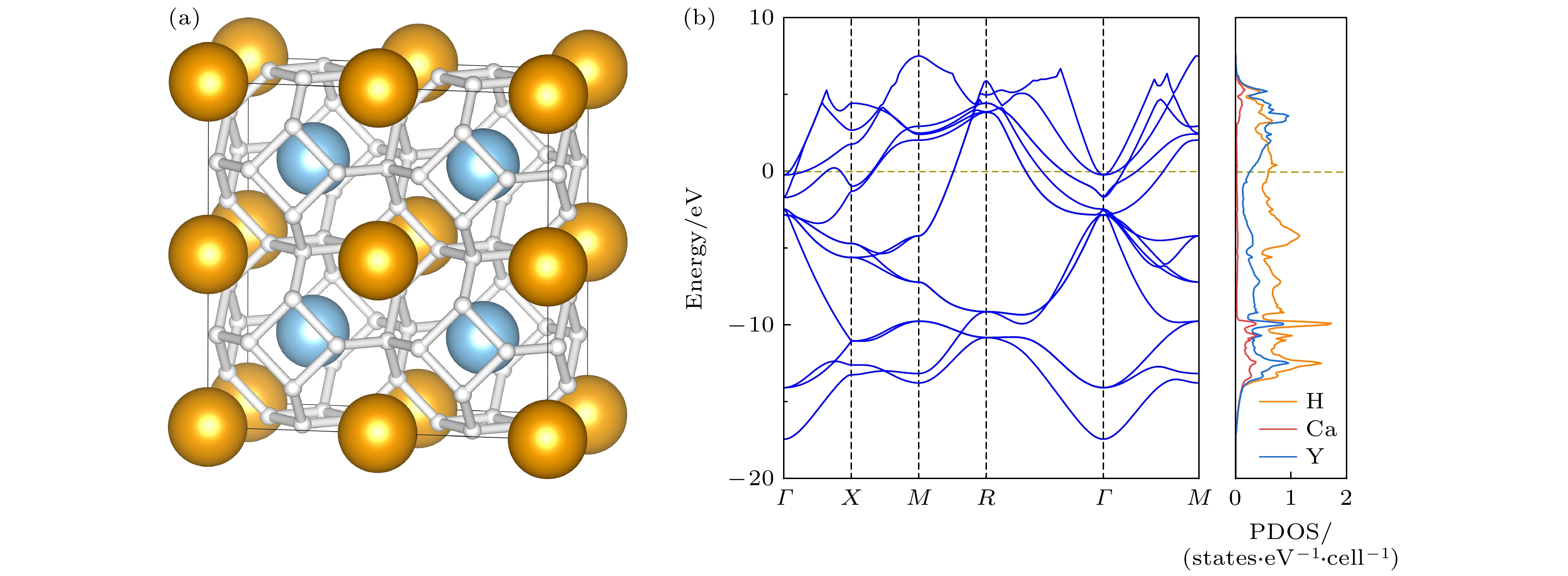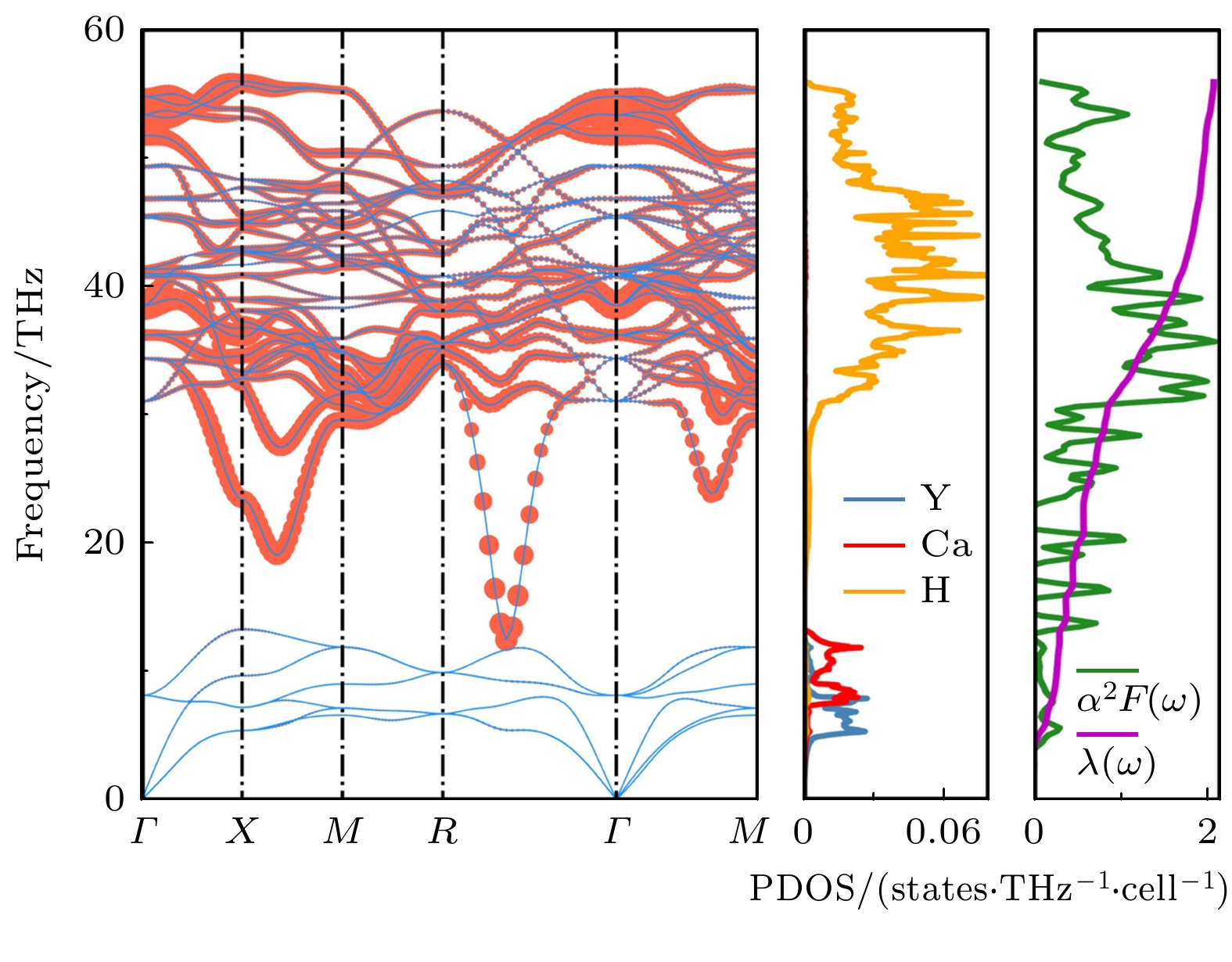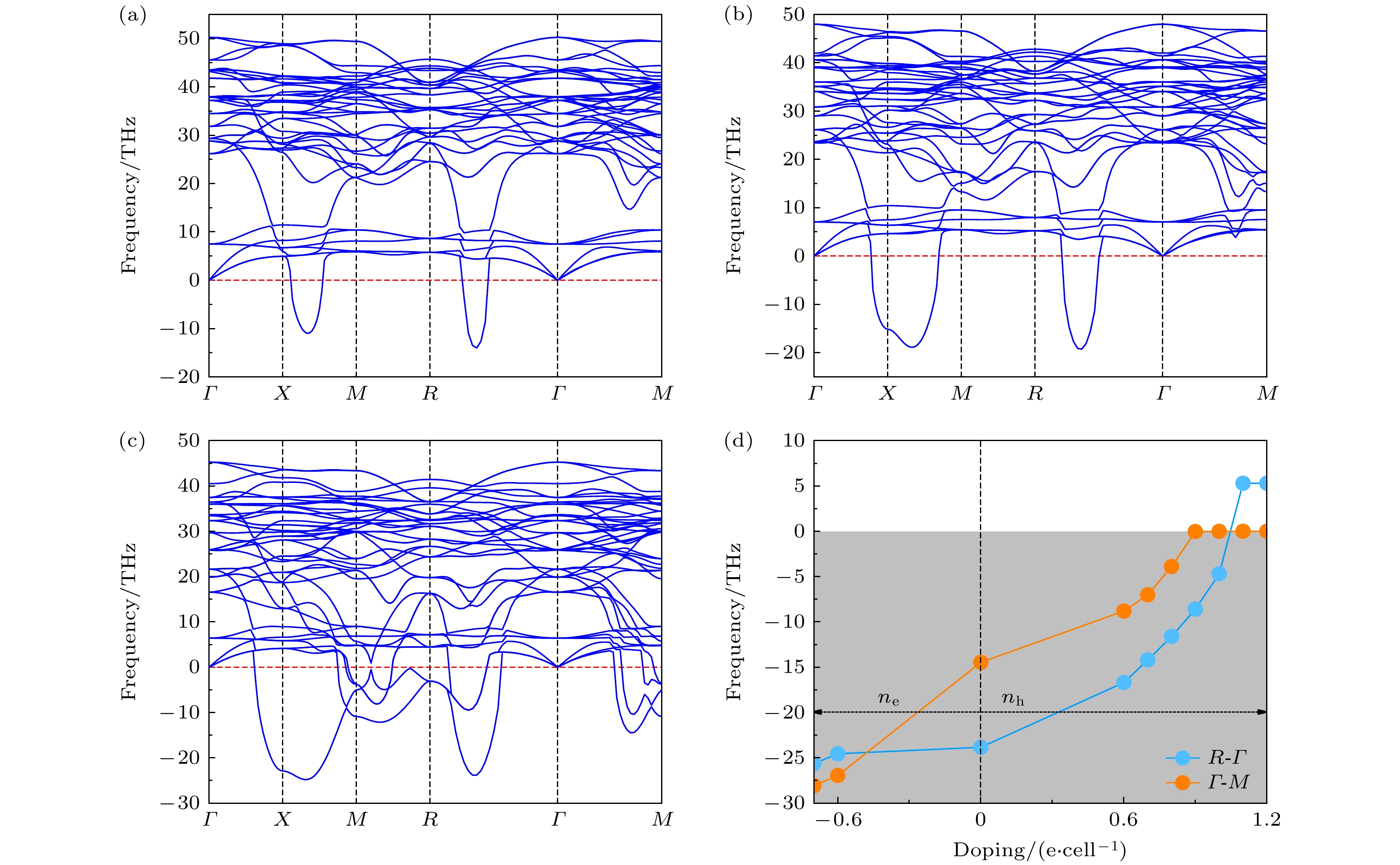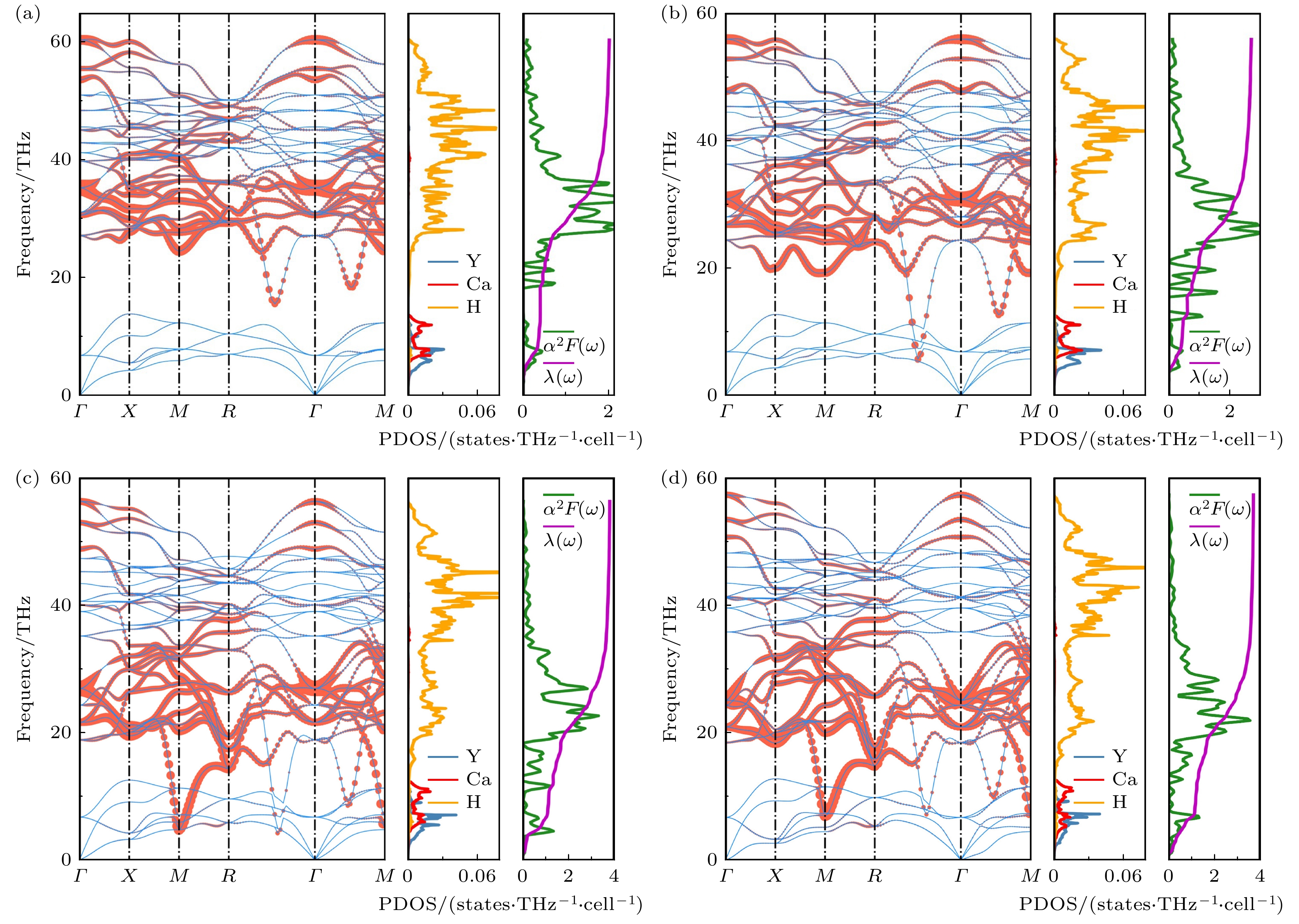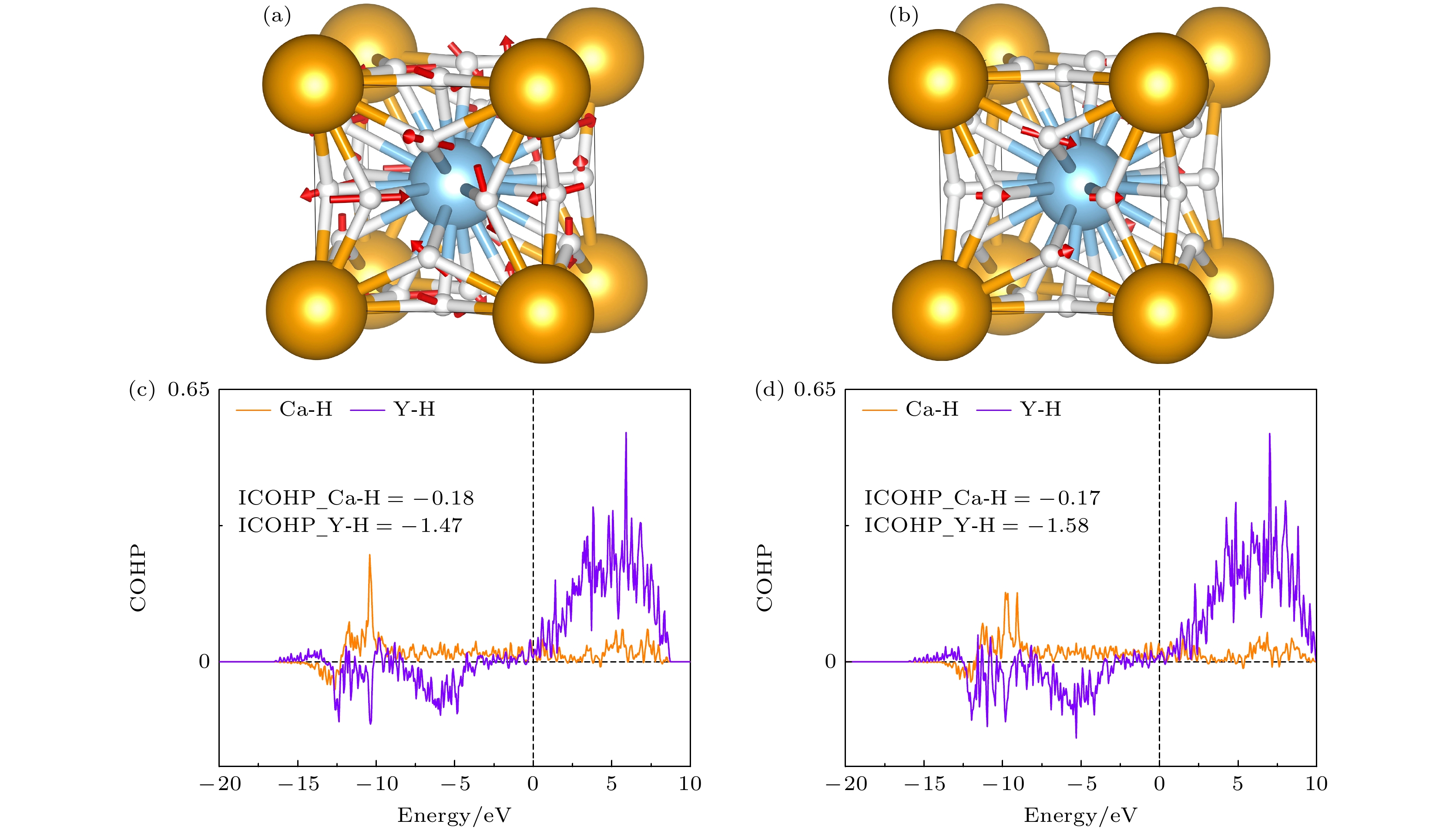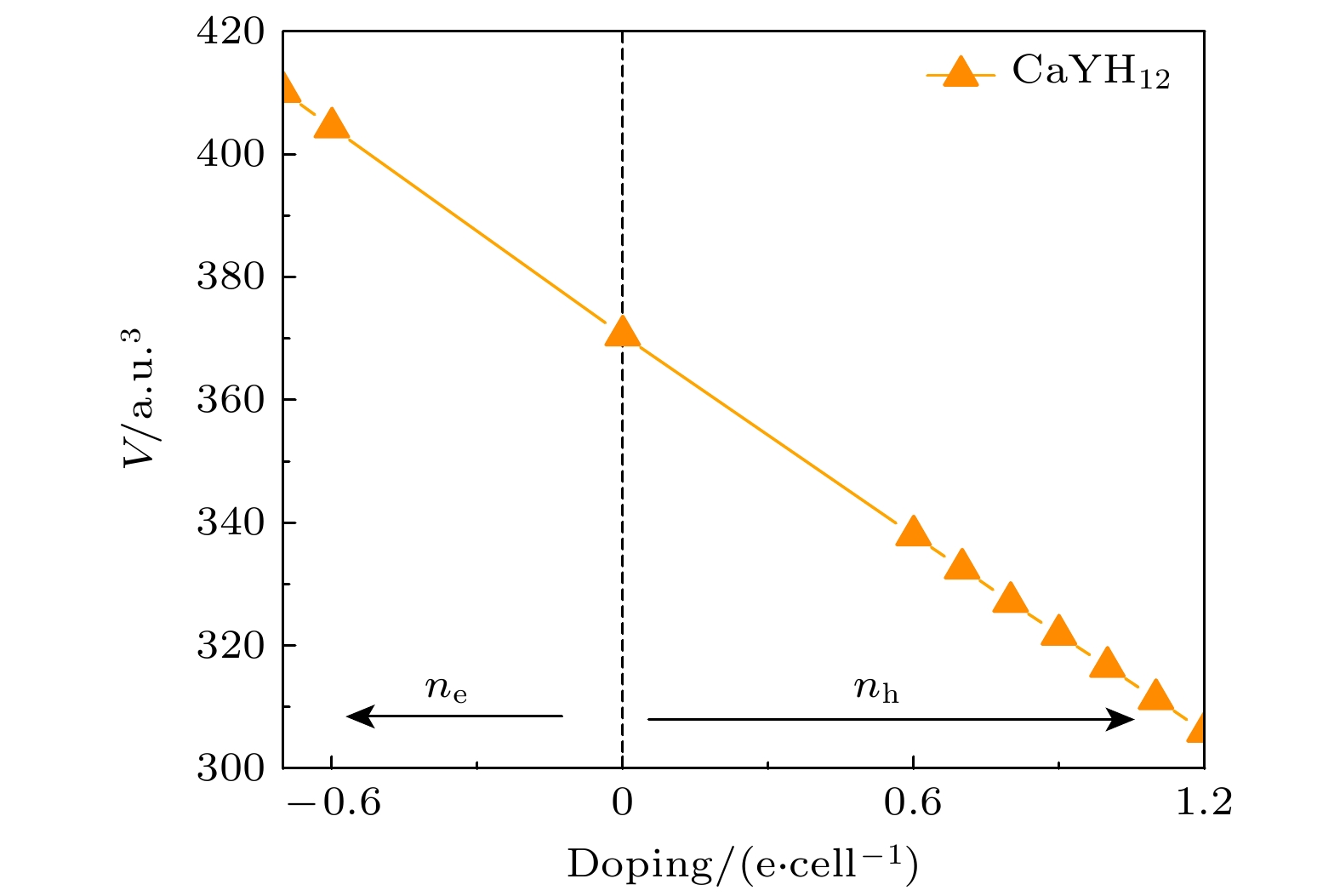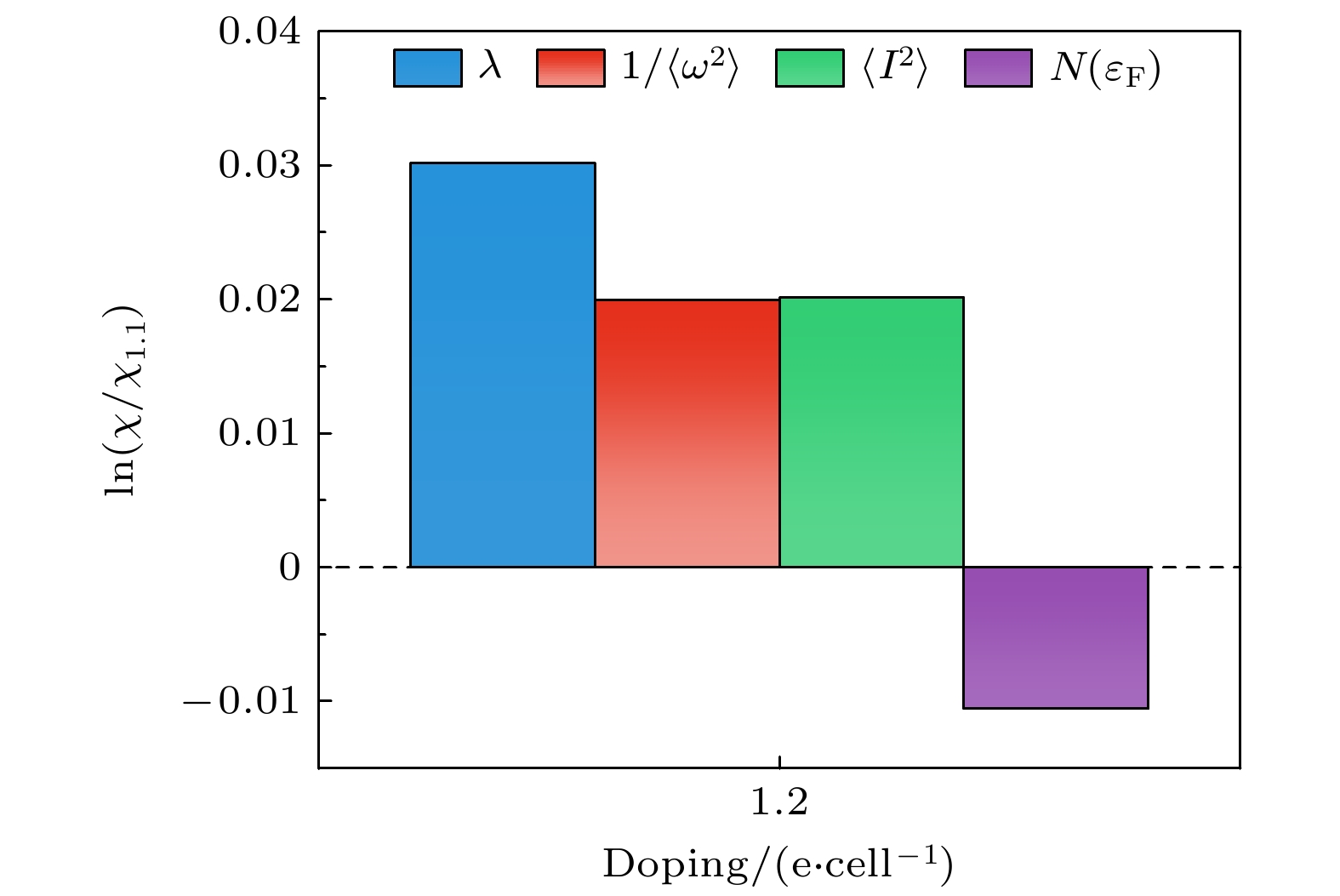-
近年来, 高压下的富氢化合物被认为是室温超导体的最佳候选体系之一, 如何降低富氢化合物稳定所需压力并保持其优异超导电性是目前该领域重要的科学问题. 研究利用第一性原理计算方法探索了电子及空穴掺杂对三元氢化物$ Pm\bar 3m $(CaYH12)动力学稳定性和超导电性的调控作用. 结果表明, 空穴掺杂可在晶格中产生“化学预压缩”效应, 消除其在较低压力下的虚频声子, 使其在较低压力下保持动力学稳定. 当空穴掺杂浓度达到1.1 e/cell时, $ Pm\bar 3m $(CaYH12)的动力学稳定压力由180 GPa降至70 GPa, 且同时可以保持约194 K的超导转变温度. 由此可见, 空穴掺杂是一种实现$ Pm\bar 3m $(CaYH12)超导电性优化(低稳定压力、高温超导)的有效策略. 本工作为三元氢化物在较低压力下实现高温超导提供了新途径, 并为相关实验研究提供了理论支撑.In the past few decades, achieving room-temperature superconductivity has become an unremitting pursuit of scientists. Guided by the “chemical precompression” theory, hydrogen-rich compounds have emerged as the main candidates for high-temperature superconductors, positioning them at the forefront of superconducting materials research. Extensive computational studies have identified numerous binary hydrides with predicted superconducting transition temperatures (Tc) exceeding 200 K, such as CaH6, H3S, MgH6, YH6, YH9, YH10, and LaH10. Significantly, the high-Tc super-conductivities of H3S, LaH10, CaH6, YH6, YH9 have been experimentally confirmed. Compared with binary hydrides, ternary hydrides offer more diverse chemical compositions and structures, potentially leading to enhanced properties. Zhang et al. [Zhang Z, Cui T, Hutcheon M J, Shipley A M, Song H, Du M, Kresin V Z, Duan D F, Pickard C J, Yao Y 2022 Phys. Rev. Lett. 128 047001] theoretically designed a series of AXH8-type (A = Sc, Ca, Y, Sr, La, Ba; X = Be, B, Al) ternary hydrides with “fluorite-type” backbone, which were predicted to have high-Tc values under moderate pressure. Among those ternary hydrides, LaBeH8 has been experimentally confirmed to achieve a Tc value of 110 K at 80 GPa. The Tc values of ternary clathrate hydrides of Li2MgH16 and Li2NaH17 have been predicted to greatly exceed the room temperature, while the required stabilization pressures all exceeded 200 GPa. Xie et al. [Xie H, Duan D F, Shao Z J, Song H, Wang Y C, Xiao X H, Li D, Tian F B, Liu B B, Cui T 2019 J. Phys. Condens. Matter. 31 245404] and Liang et al. [Liang X W, Bergara A, Wang L Y, Wen B, Zhao Z S, Zhou X F, He J L, Gao G Y, Tian Y J 2019 Phys. Rev. B 99 100505(R)] independently predicted CaYH12 compounds with $ Pm\bar 3m $ and $ Fd\bar 3m $ space groups, both of which exhibited high-Tc above 200 K at about 200 GPa. Other ternary hydrides, such as La-B-H, K-B-H, La-Ce-H, and Y-Ce-H, have also been extensively investigated. At current stage, a major focus of superconducting hydrides is to achieve high-temperature superconductivity at lower pressures. In this study, taking $ Pm\bar 3m $ (CaYH12) as a representative, we systematically investigate the effects of electron and hole doping on the dynamical stability and superconductivity in ternary hydride by first-principal calculations. The $ Pm\bar 3m $ (CaYH12) exhibits a Tc value of 218 K at 200 GPa, which is consistent with that reported previously. When decompressing to below 180 GPa, imaginary phonons emerge. The analysis of doping simulations demonstrates that the electron doping exacerbates the softening of the imaginary phonons, whereas hole doping eliminates the imaginary frequencies. At the pressures of 130, 100 and 70 GPa, the $ Pm\bar 3m $ (CaYH12) phase can be stabilized by hole doping at the concentrations of 0.9, 0.8, and 1.1 e/cell, respectively. Further electron-phonon coupling calculations show that the Tc values of $ Pm\bar 3m $ (CaYH12) at 130, 100 and 70 GPa are 194, 209, and 194 K at the corresponding doping level, which are only 10–20 K less than the Tc at 200 GPa. At the pressure of 70 GPa, Tc slightly decreases to 189 K at a doping level of 1.2 e/cell, primarily due to the reduced ωlog compared with that in the case of 1.1 e/cell. And the enhanced λ at 1.2 e/cell is mainly contributed by the average electron-phonon coupling matrix element $ \langle {I^2}\rangle $ and average phonon frequency $ {\langle {\omega ^2}\rangle ^{1/2}} $, rather than the electronic density of states at the Fermi level N(εF). These results indicate that hole doping represents a promising and effective strategy for optimizing the superconductivity of $ Pm\bar 3m $ (CaYH12) by maintaining high-Tc at low pressures. Our study paves an avenue for realizing high-temperature superconductors at low pressure.
-
Keywords:
- superconducting ternary hydride /
- first-principles calculations /
- hole doping /
- stabilization pressure regulation
-
图 1 (a)—(c)截断能、K网格、q网格收敛性测试; 基于PBE与(d) PBE+U(U = 2)和(e) PBE+U(U = 4)计算的$ Pm\bar 3 m $(CaYH12)在200 GPa压力下能带对比图
Fig. 1. (a)–(c) Convergence test of cutoff energy, K-point mesh and q-point mesh; the comparison of band structure for $ Pm\bar 3 m $(CaYH12) at 200 GPa based on PBE and (d) PBE+U(U = 2) and (e) PBE+U(U = 4).
图 2 $ Pm\bar 3 m $(CaYH12)在200 GPa压力下 (a)晶体结构, 橙色代表Ca原子, 蓝色代表Y原子, 白色代表H原子; (b)能带结构和电子态密度
Fig. 2. The $ Pm\bar 3 m $(CaYH12)at 200 GPa: (a) Crystal structure, where the orange spheres represent Ca atoms, the blue spheres represent Y atoms, and the white spheres represent H atoms; (b) band structure and electronic density of states.
图 3 $ Pm\bar 3 m $ (CaYH12)在200 GPa压力下声子谱、声子态密度、Eliashberg声子谱函数α2F(ω)以及积分λ(ω). 红色圆圈的大小代表声子线宽的数值相对大小
Fig. 3. Phonon spectrum, phonon density of states, Eliashberg phonon spectral function α2F (ω), and the integral λ(ω) of $ Pm\bar 3 m $ (CaYH12) at 200 GPa. The size of the red circles represents the relative magnitude of the phonon linewidth.
图 4 $ Pm\bar 3 m $(CaYH12)在(a) 130 GPa, (b) 100 GPa和(c) 70 GPa压力下的声子谱; (d) 70 GPa下$ Pm\bar 3 m $(CaYH12)沿着R-Γ和Γ-M处最低声子频率随掺杂浓度变化
Fig. 4. Phonon spectrum of $ Pm\bar 3 m $(CaYH12) at (a) 130 GPa, (b) 100 GPa, and (c) 70 GPa; (d) variation of the lowest phonon frequency along the R-Γ and Γ-M paths with respect to doping concentration at 70 GPa.
图 7 声子谱、声子态密度、Eliashberg声子谱函数α2F(ω), 以及积分λ(ω) (a) $ Pm\bar 3 m $ (CaYH12)在130 GPa下掺杂0.9 e/cell空穴; (b) $ Pm\bar 3 m $ (CaYH12)在100 GPa下掺杂0.8 e/cell空穴; (c) $ Pm\bar 3 m $ (CaYH12)在70 GPa下掺杂1.1 e/cell空穴; (d) $ Pm\bar 3 m $(CaYH12)在70 GPa下掺杂1.2 e/cell空穴, 其中的红色圆圈的大小代表了声子线宽的数值相对大小
Fig. 7. Phonon spectrum, phonon density of states, Eliashberg phonon spectral function α2F(ω), and the integral λ(ω): (a) $ Pm\bar 3 m $ (CaYH12) doped with 0.9 e/cell holes at 130 GPa; (b) $ Pm\bar 3 m $ (CaYH12) doped with 0.8 e/cell holes at 100 GPa; (c) $ Pm\bar 3 m $(CaYH12) doped with 1.1 e/cell holes at 70 GPa; (d) $ Pm\bar 3 m $ (CaYH12) doped with 1.2 e/cell holes at 70 GPa; the size of the red circles represents the relative magnitude of the phonon linewidth.
图 5 $ Pm\bar 3 m $(CaYH12)在130 GPa压力下的(a), (b)虚频声学支对应的原子位移矢量图和(c), (d)晶体轨道哈密顿布局分析图, 其中(a)对应的是R-Γ路径之间的q点(0.3333, 0.3333, 0.3333), (b)对应的是X-M路径之间的q点(0.5, 0.25, 0)
Fig. 5. (a), (b)Atomic displacements corresponding to the imaginary acoustic phonon mode and (c), (d) crystal orbital Hamilton population analyses for $ Pm\bar 3 m $(CaYH12)at 130 GPa, where (a) corresponds to the q point (0.3333, 0.3333, 0.3333)between the R-Γ path, and (b) corresponds to the q point (0.5, 0.25, 0) between the X-M path.
图 8 $ Pm\bar 3 m $(CaYH12)中电声耦合相关参数, 空穴掺杂浓度增加后$ \langle {I^2}\rangle $, N(εF), λ, $ \langle {\omega ^2}\rangle $参数的变化情况, 图中下标1.1表示对应参数在掺杂1.1 e/cell空穴下的值
Fig. 8. Electron-phonon coupling parameters in $ Pm\bar 3 m $ (CaYH12), variation of parameters $ \langle {I^2}\rangle $, N(εF), λ, $ \langle {\omega ^2}\rangle $ with increasing hole doping concentration in $ Pm\bar 3 m $ (CaYH12), the subscript 1.1 in the figure denotes the corresponding values at 1.1 e/cell hole doping.
表 1 高压下$ Pm\bar 3 m $ (CaYH12)超导电性相关参数, 费米面处电子态密度N(εF)(states/spin/eV/cell)、声子频率算术平均值ωlog(K)、原子平均声子频率$ {\left\langle{{{ \omega }}^{2}}\right\rangle}^{\text{1/2}} $ (THz)、平均电声耦合矩阵元$ \left\langle{{\text{I}}^{2}}\right\rangle $ (eV/Å)2、电声耦合常数λ以及超度转变温度Tc(K)
Table 1. Superconducting parameters of $ Pm\bar 3 m $ (CaYH12)under high pressures, the parameters include the electronic density of states at the Fermi level N(εF)(states/spin/eV/cell), logarithmic average of phonon frequencies ωlog(K), average phonon frequency $ {\langle {\omega ^2}\rangle ^{1/2}} $ (THz), average electron-phonon coupling matrix element $ \langle {I^2}\rangle $ (eV/Å)2, electron-phonon coupling constant λ, and superconducting transition temperature Tc(K).
P/GPa N(εF) ωlog $ {\langle {\omega ^2}\rangle ^{1/2}} $ $ \langle {I^2}\rangle $ λ Tc 180 7.05 1051.69 186.40 20.20 2.48 217 200 7.03 1227.12 205.10 20.72 2.09 218 表 2 CaYH12掺杂超导电性相关参数, $ Pm\bar 3 m $(CaYH12)在不同空穴掺杂浓度下的费米面处电子态密度N(εF)(states/spin/eV/cell), 声子频率算术平均值ωlog(K), 原子平均声子频率$ {\langle {\omega ^2}\rangle ^{1/2}} $(THz), 平均电声耦合矩阵元$ \langle {I^2}\rangle $(eV/Å)2, 电声耦合常数λ, 及超度转变温度Tc(K)
Table 2. Superconducting parameters of doped $ Pm\bar 3 m $ (CaYH12)at high pressures, the electronic density of states at the Fermi level N(εF)(states/spin/eV/cell), logarithmic average of phonon frequencies ωlog(K), average phonon frequency $ {\langle {\omega ^2}\rangle ^{1/2}} $(THz), average electron-phonon coupling matrix element $ \langle {I^2}\rangle $(eV/Å)2, electron-phonon coupling constant λ, and superconducting transition temperature Tc(K).
Phases Doped N(εF) ωlog $ {\langle {\omega ^2}\rangle ^{1/2}} $ $ \langle {I^2}\rangle $ λ Tc 130 GPa 0.9 5.18 1106.31 187.84 23.19 2.06 194 100 GPa 0.8 5.25 944.21 159.34 21.44 2.68 209 70 GPa 1.1 5.18 661.71 130.23 20.44 3.78 194 1.2 5.13 630.92 128.94 20.86 3.89 189 -
[1] McMahon J M, Ceperley D M 2011 Phys. Rev. B 84 144515
 Google Scholar
Google Scholar
[2] Loubeyre P, Occelli F, Dumas P 2020 Nature 577 631
 Google Scholar
Google Scholar
[3] Ashcroft N W 2004 Phys. Rev. Lett. 92 187002
 Google Scholar
Google Scholar
[4] Wang H, Tse J S, Tanaka K, Iitaka T, Ma Y 2012 Proc. Natl. Acad. Sci. U. S. A. 109 6463
 Google Scholar
Google Scholar
[5] Duan D F, Liu Y X, Tian F B, Li D, Huang X L, Zhao Z L, Yu H Y, Liu B B, Tian W J, Cui T 2014 Sci. Rep. 4 6968
 Google Scholar
Google Scholar
[6] Feng X L, Zhang J R, Gao G Y, Liu H Y, Wang H 2015 RSC Adv. 5 59292
 Google Scholar
Google Scholar
[7] Li Y W, Hao J, Liu H Y, Tse J S, Wang Y C, Ma Y M 2015 Sci. Rep. 5 9948
 Google Scholar
Google Scholar
[8] Liu H, Naumov, II, Hoffmann R, Ashcroft N W, Hemley R J 2017 Proc. Natl. Acad. Sci. U. S. A. 114 6990
 Google Scholar
Google Scholar
[9] Peng F, Sun Y, Pickard C J, Needs R J, Wu Q, Ma Y 2017 Phys. Rev. Lett. 119 107001
 Google Scholar
Google Scholar
[10] 段德芳, 马艳斌, 邵子霁, 谢慧, 黄晓丽, 刘冰冰, 崔田 2017 66 036102
 Google Scholar
Google Scholar
Duan D, Ma Y B, Shao Z J, Xie H, Huang X L, Liu B B, Cui T 2017 Acta Phys. Sin. 66 036102
 Google Scholar
Google Scholar
[11] Song H, Zhang Z H, Cui T, Pickard C J, Kresin V Z, Duan D F 2021 Chin. Phys. Lett. 38 107401
 Google Scholar
Google Scholar
[12] 孙莹, 刘寒雨, 马琰铭 2017 70 017407
Sun Y, Liu H Y, Ma Y M 2021 Acta Phys. Sin. 70 017407
[13] Drozdov A P, Eremets M I, Troyan I A, Ksenofontov V, Shylin S I 2015 Nature 525 73
 Google Scholar
Google Scholar
[14] Drozdov A P, Kong P P, Minkov V S, Besedin S P, Kuzovnikov M A, Mozaffari S, Balicas L, Balakirev F F, Graf D E, Prakapenka V B, Greenberg E, Knyazev D A, Tkacz M, Eremets M I 2019 Nature 569 528
 Google Scholar
Google Scholar
[15] Salke N P, Davari Esfahani M M, Zhang Y, Kruglov I A, Zhou J, Wang Y, Greenberg E, Prakapenka V B, Liu J, Oganov A R, Lin J F 2019 Nat. Commun. 10 4453
 Google Scholar
Google Scholar
[16] Li X, Huang X, Duan D, Pickard C J, Zhou D, Xie H, Zhuang Q, Huang Y, Zhou Q, Liu B, Cui T 2019 Nat. Commun. 10 3461
 Google Scholar
Google Scholar
[17] Chen W, Semenok D V, Kvashnin A G, Huang X, Kruglov I A, Galasso M, Song H, Duan D, Goncharov A F, Prakapenka V B, Oganov A R, Cui T 2021 Nat. Commun. 12 273
 Google Scholar
Google Scholar
[18] Kong P, Minkov V S, Kuzovnikov M A, Drozdov A P, Besedin S P, Mozaffari S, Balicas L, Balakirev F F, Prakapenka V B, Chariton S, Knyazev D A, Greenberg E, Eremets M I 2021 Nat. Commun. 12 5075
 Google Scholar
Google Scholar
[19] Ma L, Zhou M, Wang Y Y, Kawaguchi S, Ohishi Y, Peng F, Liu H Y, Liu G T, Wang H B, Ma Y M 2021 Phys. Rev. Research 3 043107
 Google Scholar
Google Scholar
[20] Ma L, Wang K, Xie Y, Yang X, Wang Y Y, Zhou M, Liu H Y, Yu X H, Zhao Y S, Wang H B, Liu G T, Ma Y M 2022 Phys. Rev. Lett. 128 167001
 Google Scholar
Google Scholar
[21] Li Z W, He X, Zhang C L, Wang X C, Zhang S J, Jia Y T, Feng S M, Lu K, Zhao J F, Zhang J, Min B S, Long Y W, Yu R C, Wang L H, Ye M Y, Zhang Z S, Prakapenka V, Chariton S, Ginsberg P A, Bass J, Yuan S H, Liu H Z, Jin C Q 2022 Nat. Commun. 13 2863
 Google Scholar
Google Scholar
[22] Wang Y Y, Wang K, Sun Y, Ma L, Wang Y C, Zou B, Liu G T, Zhou M, Wang H B 2022 Chin. Phys. B 31 106201
 Google Scholar
Google Scholar
[23] Zhang X H, Zhao Y P, Yang G C 2022 Wires Comput. Mol. Sci. 12 e1582
 Google Scholar
Google Scholar
[24] Liu P Y, Wang C, Zhang D Y, Wang X, Duan D F, Liu Z, Cui T 2024 J. Phys. Condens. Matter. 36 353001
 Google Scholar
Google Scholar
[25] Sun Y, Zhong X, Liu H, Ma Y 2024 Natl. Sci. Rev. 11 nwad270
 Google Scholar
Google Scholar
[26] Zhao W, Huang X, Zhang Z, Chen S, Du M, Duan D F, Cui T 2024 Natl. Sci. Rev. 11 nwad307
 Google Scholar
Google Scholar
[27] Li B, Yang Y Q, Fan Y X, Zhu C, Liu S L, Shi Z X 2023 Chin. Phys. Lett. 40 097402
 Google Scholar
Google Scholar
[28] Zhang Z, Cui T, Hutcheon M J, Shipley A M, Song H, Du M, Kresin V Z, Duan D F, Pickard C J, Yao Y 2022 Phys. Rev. Lett. 128 047001
 Google Scholar
Google Scholar
[29] Song Y G, Bi J K, Nakamoto Y, Shimizu K, Liu H Y, Zou B, Liu G T, Wang H B, Ma Y M 2023 Phys. Rev. Lett. 130 266001
 Google Scholar
Google Scholar
[30] Sun Y, Lv J, Xie Y, Liu H Y, Ma Y M 2019 Phys. Rev. Lett. 123 097001
 Google Scholar
Google Scholar
[31] Xie H, Duan D F, Shao Z J, Song H, Wang Y C, Xiao X H, Li D, Tian F B, Liu B B, Cui T 2019 J. Phys. Condens. Matter. 31 245404
 Google Scholar
Google Scholar
[32] Liang X W, Bergara A, Wang L Y, Wen B, Zhao Z S, Zhou X F, He J L, Gao G Y, Tian Y J 2019 Phys. Rev. B 99 100505(R
[33] Liang X W, Bergara A, Wei X D, Song X X, Wang L Y, Sun R X, Liu H Y, Hemley R J, Wang L, Gao G Y, Tian Y J 2021 Phys. Rev. B 104 134501
 Google Scholar
Google Scholar
[34] Gao M, Yan X W, Lu Z Y, Xiang T 2021 Phys. Rev. B. 104 L100504
 Google Scholar
Google Scholar
[35] Chen L C, Luo T, Cao Z Y, Dalladay-Simpson P, Huang G, Peng D, Zhang L L, Gorelli F A, Zhong G H, Lin H Q 2024 Nat. Commun. 15 1809
 Google Scholar
Google Scholar
[36] An D, Conway L J, Duan D, Zhang Z, Jiang Q, Song H, Huo Z, Pickard C J, Cui T 2024 Adv. Funct. Mater. 2418692
[37] Yan X Z, Zhou X Z, Liu C F, Xu Y L, Huang Y B, Sheng X W, Chen Y M 2024 Chin. Phys. B 33 086301
 Google Scholar
Google Scholar
[38] Kong X, Gao M, Yan X W, Lu Z Y, Xiang T 2018 Chin. Phys. B 27 046301
 Google Scholar
Google Scholar
[39] Wang M, Wen H H, Wu T, Yao D X, Xiang T 2024 Chin. Phys. Lett. 41 077402
 Google Scholar
Google Scholar
[40] Wang C Z, Liu S Y, Jeon H, Yi S, Bang Y Y, Cho J H 2021 Phys. Rev. B 104 L020504
 Google Scholar
Google Scholar
[41] Yu H L, Chen Y 2022 Phys. Rev. B 106 024515
 Google Scholar
Google Scholar
[42] Giannozzi P, Baroni S, Bonini N, Calandra M, Car R, Cavazzoni C, Ceresoli D, Chiarotti G L, Cococcioni M, Dabo I 2009 J. Phys. Condens. Matter. 21 395502
 Google Scholar
Google Scholar
[43] Perdew J P, Burke K, Ernzerhof M 1996 Phys. Rev. Lett. 77 3865
 Google Scholar
Google Scholar
[44] Dronskowski R, Blöchl P E 1993 J. Phys. Chem. 97 8617
 Google Scholar
Google Scholar
[45] Nazarov M V, Leng L, Leong Y, Chen L, Arellano-Ramirez I D 2014 Mold. J. Phys. Sci. 13 106
[46] McMillan W L 1968 Phys. Rev. 167 331
 Google Scholar
Google Scholar
[47] Chan K T, Malone B D, Cohen M L 2013 Phys. Rev. B 88 064517
 Google Scholar
Google Scholar
[48] Allen P B 1972 Phys. Rev. B 6 2577
 Google Scholar
Google Scholar
[49] Ueno K, Nakamura S, Shimotani H, Ohtomo A, Kimura N, Nojima T, Aoki H, Iwasa Y, Kawasaki M 2008 Nat. Mater. 7 855
 Google Scholar
Google Scholar
[50] Ding D D, Qu Z Z, Han X Y, Han C R, Zhuang Q, Yu X L, Niu R R, Wang Z Y, Li Z X, Gan Z, Wu J S, Lu J M 2022 Nano Lett. 22 7919
 Google Scholar
Google Scholar
[51] Pei Y L, Wu H, Wu D, Zheng F, He J 2014 J. Am. Chem. Soc. 136 13902
 Google Scholar
Google Scholar
[52] Liu Z, Liu Z H, Zhuang Q, Ying J J, Cui T 2024 npj Comput. Mater. 10 281
 Google Scholar
Google Scholar
计量
- 文章访问数: 303
- PDF下载量: 13
- 被引次数: 0













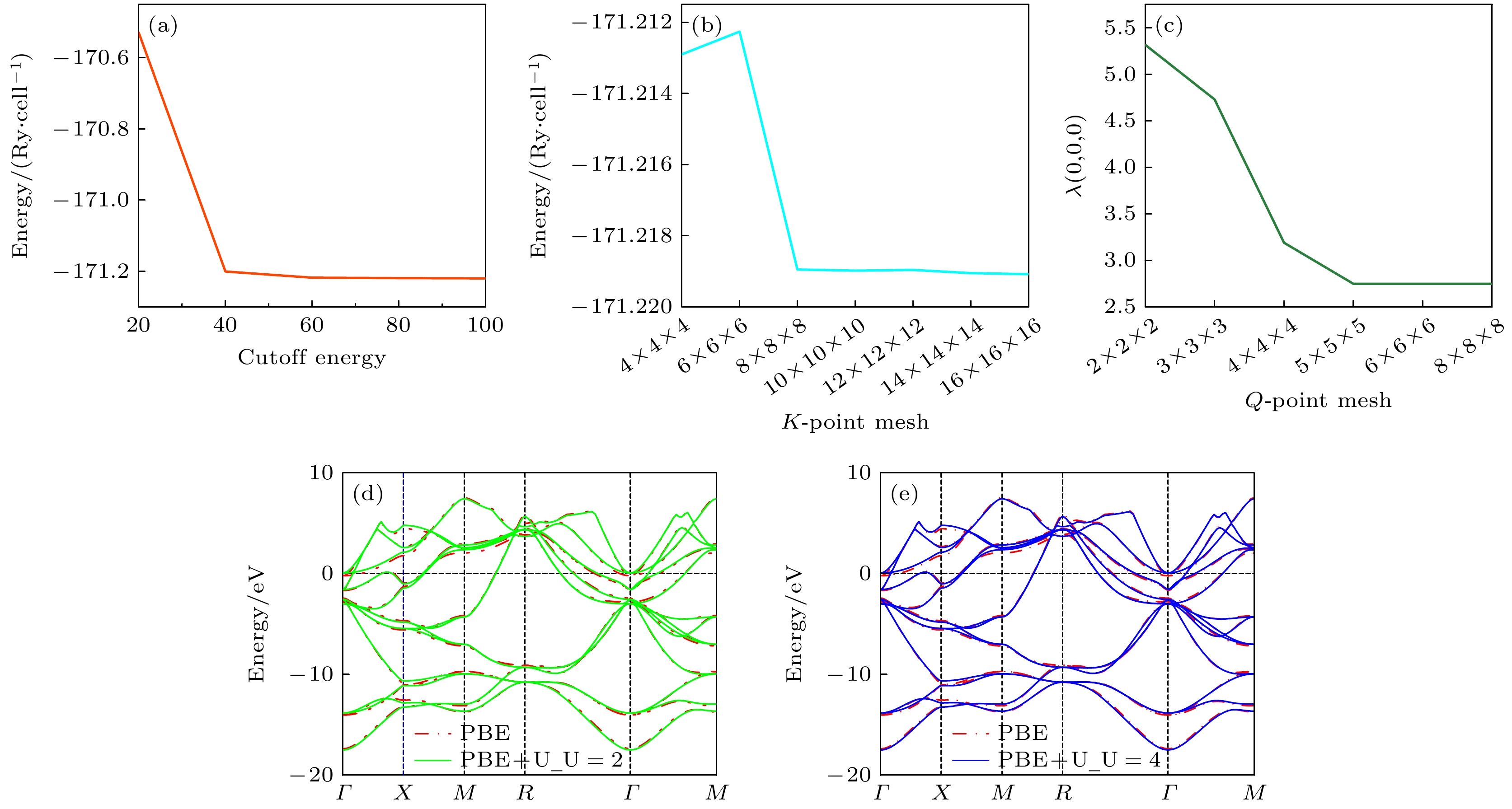
 下载:
下载:
